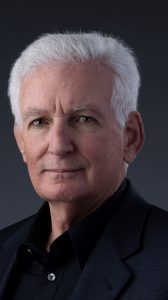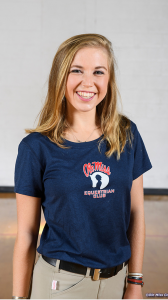
Sieg Shalles (BSChE 72) spent his career in the U.S. Navy and at the Los Alamos National Laboratory. Submitted photo
Other than earning engineering degrees from the University of Mississippi, Siegfried Shalles (BSChE 72) and Rowan Baird (BSME 20) wouldn’t seem to have much in common. He’s a retired baby boomer. She’s a recently hired Gen Zer. What other similarities could the two possibly have?
Try working for national nuclear research laboratories.
A career naval commander, Shalles worked at Los Alamos National Laboratory in New Mexico. Baird works as a research scientist at Lawrence Livermore National Laboratory in Livermore, California.
A joint Zoom conversation with the two reveals that they are bookends whose work perspectives and life experiences are similar despite the almost 50 years between them.
Similar Yet Different Beginnings
Shalles came to Ole Miss from Columbus on a Carrier scholarship in 1967. Every male student at the time had to take Reserve Officer Training Corps, or ROTC, classes for two years because that was a requirement for all land-grant colleges in the United States. Shalles chose the Navy ROTC program with no expectation that it would lead to a career choice.
“After the mandatory two years, I decided to continue in the Navy ROTC program, which led to summer cruises on a destroyer out of San Diego and a real patrol on a ballistic missile submarine out of Holy Loch, Scotland,” he said. “These experiences sealed the deal for me. For a small-town boy from Mississippi, ‘join the Navy and see the world’ was a reality.”
Almost 50 years later, Baird decided to attend Ole Miss. The Baton Rouge, Louisiana, native discovered an interest in physics and math. Those academic skills combined with her curiosity about how things fit together, work and break pointed her toward engineering. However, the high school senior was torn between the application of engineering and the creative freedom of business.
“When looking at schools, I knew I needed to attend somewhere that had both,” she said. “After touring around the SEC and looking into other schools outside of SEC, Ole Miss was the best school because it was close enough to home, had good programs for engineering and business and – to top it all off – I fell in love with Oxford.”
As a mechanical engineering student, Baird toured the Blast and Impact Dynamics Laboratory on campus in the mechanical engineering introductory course her freshman year. Two years later, she became an undergraduate researcher at the Blast Lab when instructor Damian Stoddard offered her a position after her performance in his Materials Science lab course.
“It is what got me really involved with research and set me on the path that got me to where I am today,” she said.
Similar Yet Different Niches
During Shalles’ last year at Ole Miss, his Navy ROTC adviser suggested that he apply for the nuclear power submarine program. After interviews in Washington, D.C., with technical personnel and Adm. Hyman G. Rickover, Shalles was accepted and spent the first year after graduation in the Navy nuclear propulsion training program.
“This was 1972, and the Cold War was at its height,” he said. “The Navy was building nuclear-powered submarines as fast as it could, and men were needed to take them to sea to oppose the Soviet Union. The admiral must have concluded that I was a suitable officer for his program, a decision that, unknown to me, would fix the trajectory of my life.”
That trajectory included sea tours on six nuclear-powered submarines, including command of the fast attack submarine USS Archerfish (SSN 678) and the Ohio-class ballistic missile submarine USS Alabama (SSBN 731), and culminating with an assignment at U.S. Strategic Command near Omaha, Nebraska.
Fast-forward to May 2020, when Baird received her degree in mechanical engineering. Her research led to her finding employment with Lawrence Livermore National Laboratory. Seven months in, Baird said she’s enjoying the job.
“The lab has done a lot to make sure their employees are healthy, educated on the situation and interested in what we work on,” she said. “It is comforting to know that even though my experience is in one area, mechanical properties, I am encouraged to explore other areas of interest.
“And if one day I want to adjust my workload to reflect the other interests, I have the option to stay with the lab but change my specification. Not to mention the opportunity to continue my education with the lab’s blessing and funding to boot.”
Looking Back, Going Forward
After Shalles’ command tour on USS Alabama, he was assigned to U.S. Strategic Command near Omaha, Nebraska, to stand up a new division in that command. After a year, his boss asked Shalles to transfer to Los Alamos National Laboratory as the liaison officer representing U.S. Strategic Command’s equities to the national nuclear weapons laboratories (Los Alamos National Laboratory, Lawrence Livermore National Laboratory and Sandia National Laboratories).
“I was happy to relocate to New Mexico,” Shalles said. “After two years in Los Alamos, I retired from the Navy and took a job at Los Alamos National Laboratory as a coordinator for compiling, editing and issuing the multiple required reports that summarized the assessments of the nuclear weapons.
“Because of the education that I received at Ole Miss and the training in the Navy, I was able to translate the very detailed data provided by the technical staff at the laboratory into understandable English that was comprehensible to nontechnical audiences outside the laboratory.”
Meanwhile, Baird helped restart a UM chapter of the Society of American Military Engineers, also known as SAME. The Engineer Research Development Center has an active professional chapter that technically “oversees” the Ole Miss chapter and hosted tour trips of its facility in Vicksburg.
Ned Mitchell, a member of the Vicksburg professional chapter and professor at Ole Miss, assisted Baird with guidance on how to establish the chapter from the SAME national organization level and was/is one of the SAME chapter faculty advisers.
“SAME was something that tied my two passions into one,” Baird said. “I’ve always wanted to give back to the country that provided and currently provides me so much, but I wasn’t sure how to go about it. I started looking into ways I could use my degree to follow that passion [after graduation].
“I discovered SAME and approached a few faculty members about technically restarting a chapter at Ole Miss. With the right information and many phone calls, we got the ball rolling and here we are.”
Similar Words of Wisdom
Shalles and Baird wished to offer some words of wisdom to future UM engineers.
“There are many unique career paths in all the military services for engineers regardless of their degree,” Shalles said. “There are opportunities for pure research, construction and infrastructure management, weapons development, combat-related positions and other niche specialties.
“If one is interested in serving the country in a military environment, do the research to make sure you are aware of the available careers. You will probably be surprised at the opportunities.”
Baird encouraged students to apply to anything and everything that sparks their interests and not to sell themselves short.
“I almost talked myself out of applying to the lab because I wasn’t sure I would make the cut,” she said. “Thankfully, someone reminded me the worst thing they can say is no and your situation hasn’t changed. If you’re one of the students whose previous work experience led straight to a full-time position: congratulations. If you are like me and didn’t have that opportunity, don’t lose heart. Keep applying. Keep reaching out. Keep pushing yourself because you never know where or when the right job will appear.”
